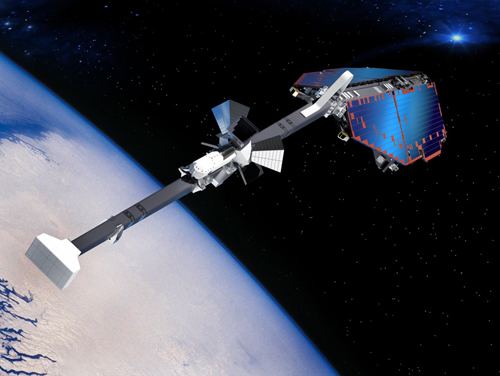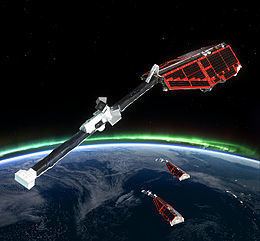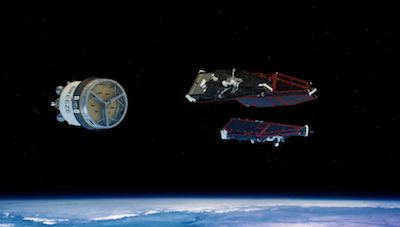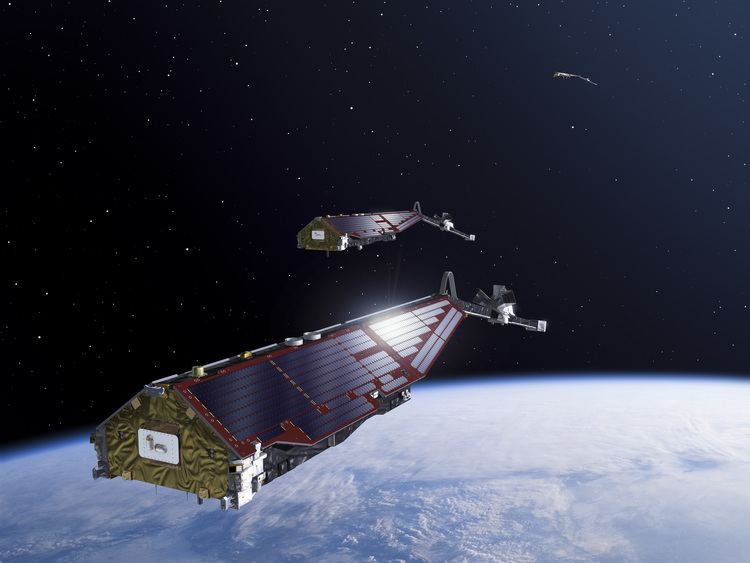Operator ESA Mission duration 4 years (planned) | Website eoPortal - SWARM | |
COSPAR ID SWARM A: 2013-067BSWARM B: 2013-067ASWARM C: 2013-067C SATCAT no. SWARM A: 39452SWARM B: 39451SWARM C: 39453 | ||
Swarm is a European Space Agency (ESA) mission to study the Earth's magnetic field. High-precision and high-resolution measurements of the strength, direction and variations of the Earth's magnetic field, complemented by precise navigation, accelerometer and electric field measurements, will provide data essential for modelling the geomagnetic field and its interaction with other physical aspects of the Earth system. The results will offer a unique view of the inside of the Earth from space, enabling the composition and processes of the interior to be studied in detail and increase our knowledge of atmospheric processes and ocean circulation patterns that affect climate and weather.
Contents
- Overview
- Scientific objectives
- Payload
- Pre launch
- Launch
- Operations
- Discoveries and applications
- References

Overview

The overall objective of the Swarm mission is to build on the experience from the Ørsted and CHAMP missions and to provide the best ever survey of the geomagnetic field (multi-point measurements) and its temporal evolution, to gain new insights into the Earth system by improving our understanding of the Earth's interior and climate.

The Swarm constellation consists of three satellites (Alpha, Bravo & Charlie) placed in two different polar orbits, two flying side by side at an altitude of 450 km (280 mi) and a third at an altitude of 530 km (330 mi). The launch was delayed and rescheduled to 12:02:29 UTC (7:02:29 a.m. EST) on 22 November 2013, from Plesetsk Cosmodrome, Russia. ESA contracted Astrium to develop and build the three orbiters, while Eurockot provided the launch services.
Scientific objectives
Primary objectives:

Secondary objectives:
Payload
The payload of the three spacecraft consists of the following instruments:
Pre-launch
The three SWARM satellites arrived at the Plesetsk Cosmodrome in September 2013 to begin final testing before fuelling and incorporation with the Rokot launch vehicle.
Launch
The SWARM constellation was successfully launched aboard Rokot/Briz-KM on November 22, 2013.
Operations
The constellation is controlled by the European Space Operations Centre in Darmstadt, Germany. By the beginning of May 2014 SWARM had finished its in orbit commissioning. Preliminary data indicates that the constellation is performing well as data received closely matches that from a previous German mission, CHAMP.
During the commissioning stage problems were discovered with the backup Magnetometer on the 'Charlie' satellite, this led to 'Bravo' satellite being placed in the lone high altitude orbit (510km) with 'Charlie' joining 'Alpha' in the lower tandem orbit (462km) to improve the resilience of the constellation. Commissioning data also indicated greater noise in data when a satellite was in view of the sun, the current theory is this is caused due to differential heating in the satellite but this has not been confirmed. Overall the constellation is in good health and due to accurate orbital insertion has significant fuel reserves remaining.
Discoveries and applications
In September 2016 scientists published a study that revealed a direct link between GPS blackouts of low-earth orbiting satellites and 'thunderstorms' in the ionosphere. During the first two years of Swarm's operation their GPS connection was broken 166 times. The high-resolution observations from the satellite helped to link these outages to ionospheric thunderstorms 300-600km in the Earth's atmosphere.
In December 2016 scientists announced that, by using data from the Swarm satellites, they had discovered a new feature in the Earth's outer core. A jet-stream of rapidly moving liquid iron moving at around 50 km per year.
